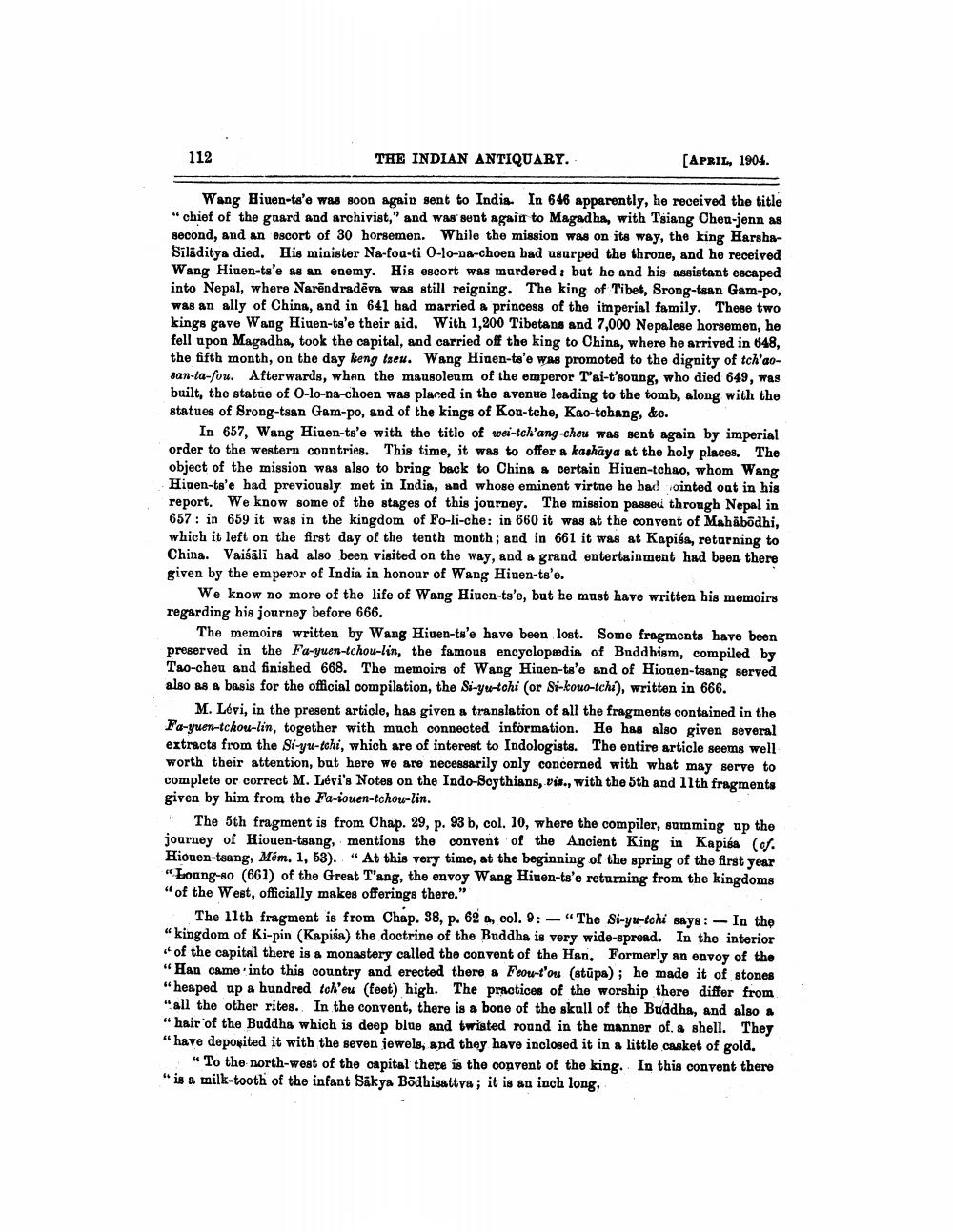________________
112
THE INDIAN ANTIQUARY.
[APRIL, 1904.
Wang Biuen-ts'e was soon again sent to India In 646 apparently, he received the title "chief of the guard and archivist," and was sent again to Magadha, with Tsiang Chen-jenn as second, and an escort of 30 horsemen. While the mission was on its way, the king HarshaSilāditya died. His minister Na-foa-ti 0-1o-na-choen had usurped the throne, and he received Wang Hinen-ta'e as an enemy. His escort was mardered: but he and his assistant escaped into Nepal, where Narendradeva was still reigning. The king of Tibet, Srong-tsan Gam-po, was an ally of China, and in 641 had married a princess of the imperial family. These two kings gave Wang Hiden-ts'e their aid. With 1,200 Tibetans and 7,000 Nepalese horsemen, he fell upon Magadha, took the capital, and carried off the king to China, where he arrived in 648, the fifth month, on the day keng tseu. Wang Hinen-ts'e was promoted to the dignity of tch'aosan-ta-fou. Afterwards, when the mausoleum of the emperor T'ai-t'soung, who died 649, was built, the statue of O-lo-na-choen was placed in the avenue leading to the tomb, along with the statues of Srong-tsan Gam-po, and of the kings of Koa-tche, Kao-tcbang, &c.
In 657, Wang Hinen-ts'e with the title of wei-tch'ang-cheu was sent again by imperial order to the western countries. This time, it was to offer a kashaya at the holy places. The object of the mission was also to bring back to China a certain Hiuen-tchao, whom Wang Higen-ts'e had previously met in India, and whose eminent virtue he had! ointed out in his report. We know some of the stages of this journey. The mission passed through Nepal in 657: in 659 it was in the kingdom of Fo-li-che: in 660 it was at the convent of Mahābõdhi, which it left on the first day of the tenth month, and in 661 it was at Kapiba, returning to China. Vaiśāli had also been visited on the way, and a grand entertainment had been there given by the emperor of India in honour of Wang Hinen-ts'e.
We know no more of the life of Wang Hiuen-ts'e, but he must have written his memoirs regarding his journey before 666.
The memoirs written by Wang Hiuen-ts'e have been lost. Some fragments have been preserved in the Fa-yuen-tchou-lin, the famous encyclopædia of Buddhism, compiled by Tao-cheu and finished 668. The memoirs of Wang Hinen-ts'e and of Hionen-tsang served also as a basis for the official compilation, the Si-yu-tchi (or Si-kouo-tchi), written in 666.
M. Lévi, in the present article, has given a translation of all the fragments contained in the Fa-yuen-tchou-lin, together with much connected information. He has also given several extracts from the Si-yu-tchi, which are of interest to Indologists. The entire article seems well worth their attention, but here we are necessarily only concerned with what may serve to complete or correct M. Lévi's Notes on the Indo-Scythians, vis., with the 5th and 11th fragments given by him from the Fa-louen-tchou-lin.
The 5th fragment is from Chap. 29, p. 93 b, col. 10, where the compiler, summing up the journey of Hiouen-tsang, mentions the convent of the Ancient King in Kapisao Hiouen-tsang, Mém. 1, 53). "At this very time, at the beginning of the spring of the first year
Loung-80 (661) of the Great T'ang, the envoy Wang Hiuen-ts'e returning from the kingdoms "of the West, officially makes offerings there."
The 11th fragment is from Chap. 98, p. 62 , col. 9: - "The Si-yu-tchi says: - In the “ kingdom of Ki-pin (Kapisa) the doctrine of the Buddha is very wido-spread. In the interior * of the capital there is a monastery called the convent of the Han, Formerly an envoy of the "Han came into this country and erected there a Feow-t'ou (stupa); he made it of stones "heaped up a hundred tohleu (feet) high. The practices of the worship there differ from "all the other rites. In the convent, there is a bone of the skull of the Buddha, and also a "hair of the Buddha which is deep blue and twisted round in the manner of a shell. They "have deposited it with the seven jewels, and they have inclosed it in a little casket of gold.
"To the north-west of the capital there is the convent of the king. In this convent there " is a milk-tooth of the infant Säkya Bödhisattva; it is an inch long,




